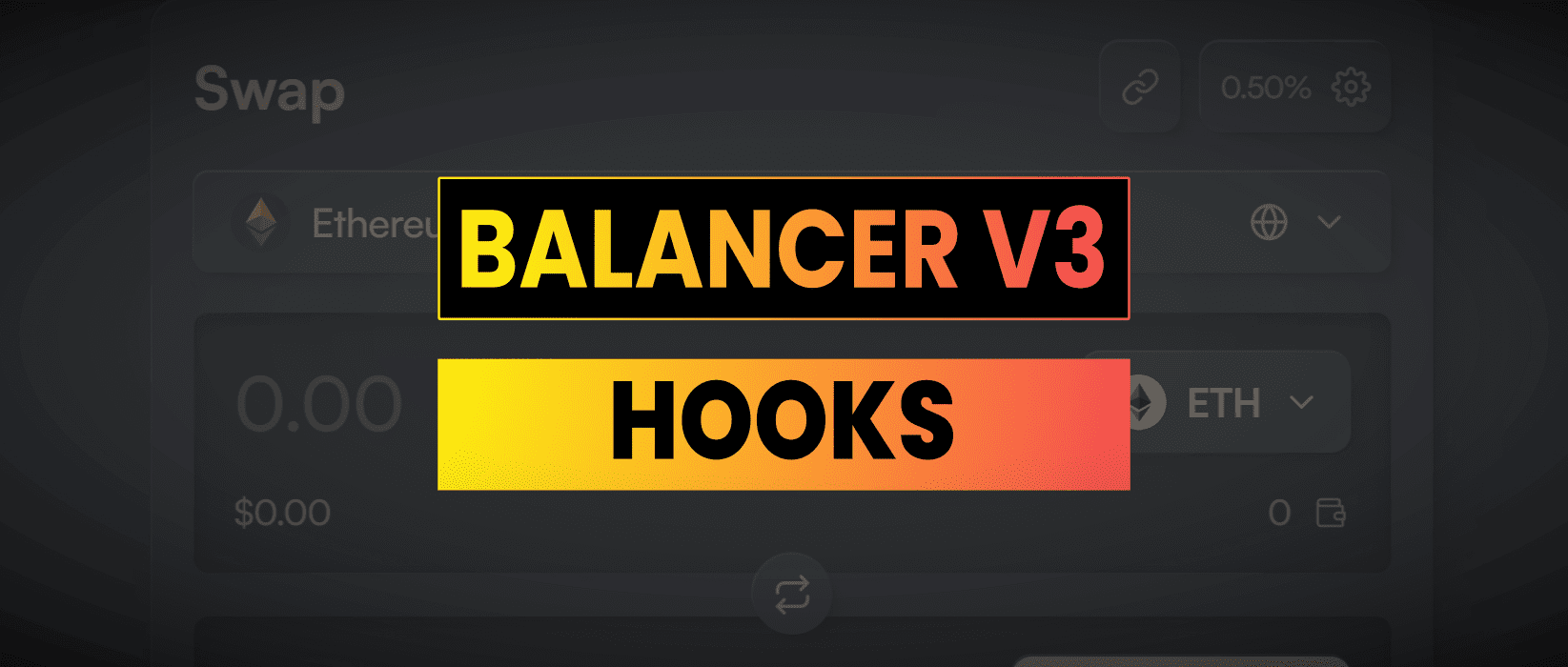For the Balancer v3 Hookathon (yep it’s a hackathon to create DeX hooks) I had the idea to try and create a fair launch memecoin platform.
It’s the kind of thing that could bring utility to the ecosystem as we’ve seen recently with the wave of memecoin trading on Solana.
The target is to create a liquidity pool where liquidity can’t be removed and there’s a cap set on how many tokens can be sold at any one time. Originally I thought that this could be linked to a users address but this would be easily gameable by moving tokens around mid transaction.
The method I decided upon was to impose a per block cap on the amount of tokens leaving the pool. To achieve this I used the amountInScaled18 parameter on the onAfterSwap hook.
Full Code below:
Balancer.Fun Solidity Code
// SPDX-License-Identifier: MIT
pragma solidity ^0.8.24;
import { IERC20 } from "@openzeppelin/contracts/token/ERC20/IERC20.sol";
import { IHooks } from "@balancer-labs/v3-interfaces/contracts/vault/IHooks.sol";
import { IVault } from "@balancer-labs/v3-interfaces/contracts/vault/IVault.sol";
import {
AfterSwapParams,
LiquidityManagement,
TokenConfig,
PoolSwapParams,
RemoveLiquidityKind,
HookFlags,
SwapKind
} from "@balancer-labs/v3-interfaces/contracts/vault/VaultTypes.sol";
import { VaultGuard } from "@balancer-labs/v3-vault/contracts/VaultGuard.sol";
import { BaseHooks } from "@balancer-labs/v3-vault/contracts/BaseHooks.sol";
/**
* @title BalancerFun Hook Contract
* @notice Implements custom hooks for Balancer V3 liquidity pools to enforce swap limits and prevent liquidity removal.
*/
contract BalancerFun is BaseHooks, VaultGuard {
/// @notice The token that is managed by this hook.
IERC20 public immutable token;
/// @notice The maximum amount that can be swapped in a single block.
uint public immutable maxSwapAmount;
/// @notice A mapping that tracks the total amount of tokens sold per block.
mapping(uint => uint) public blockToTotalSold;
/// @notice Event emitted when the BalancerFun hook is registered.
/// @param hooksContract The address of the hooks contract.
/// @param pool The address of the pool where the hook is registered.
event BalancerFunHookRegistered(address indexed hooksContract, address indexed pool);
/// @notice Error thrown when a swap exceeds the maximum allowed swap amount.
error MaximumSwapExceeded();
/// @notice Error thrown when an attempt is made to remove liquidity, which is not allowed.
error LiquidityIsLocked();
/**
* @notice Constructor for the BalancerFun contract.
* @param vault The Balancer Vault contract.
* @param _token The ERC20 token that is managed by this hook.
*/
constructor(IVault vault, IERC20 _token) VaultGuard(vault) {
token = _token;
maxSwapAmount = 1_000_000 ether * 3 / 100; // 3% of total supply, could use token.totalSupply()
}
/**
* @notice Returns the hook flags indicating which hook functions should be called.
* @return hookFlags The HookFlags struct indicating which hook functions are enabled.
*/
function getHookFlags() public pure override returns (HookFlags memory) {
HookFlags memory hookFlags;
hookFlags.shouldCallAfterSwap = true;
hookFlags.shouldCallAfterRemoveLiquidity = true;
return hookFlags;
}
/**
* @notice Called when the hook is registered to a pool.
* @param pool The address of the pool to which the hook is being registered.
* @return success Boolean indicating whether the registration was successful.
*/
function onRegister(
address,
address pool,
TokenConfig[] memory,
LiquidityManagement calldata
) public override onlyVault returns (bool) {
emit BalancerFunHookRegistered(address(this), pool);
return true;
}
/**
* @notice Called after a swap is performed in the pool.
* @param params The parameters for the swap, including token addresses and amounts.
* @return success Boolean indicating if the swap was successful.
* @return amountCalculatedRaw The calculated amount after the swap.
*/
function onAfterSwap(
AfterSwapParams calldata params
) public override onlyVault returns (bool, uint) {
if (address(params.tokenIn) == address(token)) {
uint currentBlockSold = blockToTotalSold[block.number];
if (currentBlockSold + params.amountInScaled18 > maxSwapAmount * 1e18) {
revert MaximumSwapExceeded();
}
blockToTotalSold[block.number] = currentBlockSold + params.amountInScaled18;
}
return (true, params.amountCalculatedRaw);
}
/**
* @notice Called after an attempt to remove liquidity from the pool.
* @dev This function always reverts with `LiquidityIsLocked()` error to prevent liquidity removal.
* @return success Boolean indicating if the function succeeded.
* @return emptyArray An empty array to satisfy return requirements.
*/
function onAfterRemoveLiquidity(
address,
address,
RemoveLiquidityKind,
uint,
uint[] memory,
uint[] memory,
uint[] memory,
bytes memory
) public view override onlyVault returns (bool, uint[] memory) {
revert LiquidityIsLocked();
}
}This Solidity smart contract is designed to interact with the Balancer V3 liquidity pools, implementing custom hooks to impose swap limits and prevent liquidity removal.
Here’s a breakdown of its key functionality:
The contract enforces restrictions on token swaps and liquidity removal in a Balancer V3 pool. Specifically, it limits the maximum amount of tokens that can be swapped in a single block and completely disallows liquidity removal.
Swap Limit Enforcement
A maximum swap amount (maxSwapAmount) is defined, limiting how much of the token can be swapped per block to avoid large-scale trades.
Liquidity Locking
Liquidity removal is fully restricted, meaning users cannot withdraw liquidity once it has been added to the pool.
This would be useful for scenarios where a token’s liquidity needs to be locked to maintain pool integrity, and swap limits need to be enforced to prevent manipulation or large-scale token dumps. It adds additional layers of control and security to token liquidity pools on Balancer V3.
More information on the hackathon can be found here: https://dorahacks.io/hackathon/balancer-v3-hookathon/


